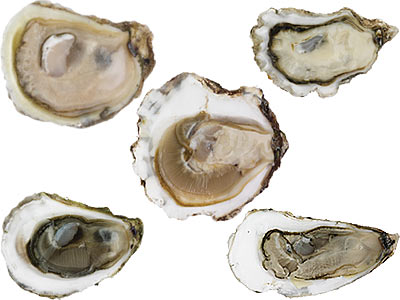
Oysters—smooth, briny, and luxurious—can make a festive and romantic holiday appetizer. Unless, that is, you poison your guests or your date, at which point the bivalves tend to lose a considerable amount of their charm. Here’s what you need to know to slurp safely and well.
Oysters are divided into two main categories, East Coast and West Coast. East Coast oysters tend to be ½rmer and chewier than West Coast. They also have more brine, which means they’re saltier. West Coast oysters are creamier and sweeter and have more of a melt-in-your-mouth texture.
The five main species of oysters regularly available in New York are the Atlantic oyster (an East Coast oyster that’s sometimes sold by the name of the location it comes from, as in Bluepoints), the European flat, or Belon (also an East Coast oyster), and the Pacific, Kumamoto, and Olympia oysters (all West Coast).
“Holiday time is a great time of year to eat oysters,” says Michael Garvey, the general manager of the famous Grand Central Oyster Bar. “They’ve been eating all fall, so they’re very healthy during these months.” Garvey recommends a host of different oysters for holiday entertaining. “The Bluepoint is an excellent local oyster and can be had relatively inexpensively,” he says. “A good beginner oyster is the Kumamoto, because it’s typically petite, and although it’s creamy, it has a firm texture and it’s not as slimy as many other varieties,” he says. Garvey also enjoys Wellfleet oysters from Cape Cod and Moonstones from Rhode Island. For the more adventurous eater, he recommends the Belon. “It’s full-flavored,” he says. “It’s almost like taking in a mouthful of seawater. Many people don’t like them, but the true oyster lover will.”
Oysters should be alive when you buy them. If an oyster is open, it may be dead. Tap it—if it’s alive, it will shut tight. If it stays open, don’t buy it. Because oysters should have their liquid intact, they should be sitting cup-side down in the store (oysters have a cup side and a flat side). If they’re kept on their flat side, their liquid will leak out. “If an oyster feels light, it means that it’s probably dry,” says Garvey. “Leave it.” Ditto if it has an off smell. Make sure that a store keeps oysters at the proper temperature, around 40 degrees, and preferably in a slightly humid environment, but not underwater (which would suffocate them).
When you get oysters home, store them in a box in the refrigerator and place a wet towel over the box to provide moisture. Oysters should be eaten as soon as possible. Because they’re not airtight, they’ll last only about a week, and they’ll quickly begin to pick up odors and flavors from the fridge.
Where to Buy
Some trustworthy oyster outlets with good selections are Pescatore Market (in Grand Central Station), Wild Edibles (also in Grand Central), and Citarella (various locations). Oysters typically cost about $2 each, though Belons can cost $3.
More Holiday Shopping Tips:
The Fanatic’s Grocery List: How To Tell A Turkey from A Turkey
And See Also:
The Feasts: Holiday Banquets to the Nth Degree